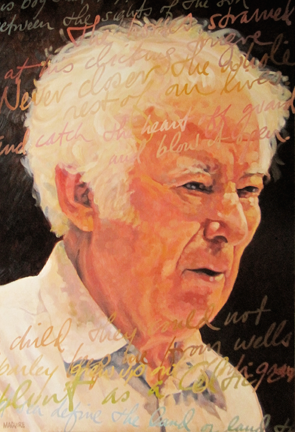By Barrie Maguire
Painting is always stressful, but painting Seamus Heaney taught me the meaning of the word.
All of my previous Irish Writer paintings, eleven of them, had been of deceased giants of Irish Literature, from Joyce to Yeats, from Synge to Shaw. They were all based on famous images, interpreted in any way I chose, highly stylized with bright splashy colors.
 But a painting of a living legend like Seamus Heaney would have to be a different thing altogether… after all, the man might actually see it. And he might actually hate it.
But a painting of a living legend like Seamus Heaney would have to be a different thing altogether… after all, the man might actually see it. And he might actually hate it.
When I learned early last year that Heaney would be speaking at Villanova University in April of 2010, I decided to take the plunge, hoping to get my painting in the same room with him when he came to town.
I attended Heaney’s reading at Princeton University in April 2009 and took several photos of him from my front row seat. The lighting was excellent and now I had my own research to paint from.
It was the fall before I could begin the painting and I labored over it through the winter. My Irish Writer paintings are very big, four-and-a-half feet high, and merely covering the canvas with paint is a long march. As I attacked the painting, my mood, as it always does, ricocheted from excitement to despair to giddiness and back. My wife Karen wisely avoided any discussion of the painting or visits to the studio. She had long ago learned to roll her eyes and keep her mouth shut if I came in the house with that look on my face.
As I painted away, I couldn’t decide if the painting even looked like him or not, a rather critical question, but I plowed ahead. Finally one day in February I threw up my hands and announced to myself, “It’s done.” That is the image was done, but not the painting. Now I needed to add the text, a part of all my Writers paintings.
I had spent the previous month immersed in Seamus Heaney poetry, looking for a few brilliant lines that would sum up what I love about his work. I had found several moving poems that spoke to me, but I could not find any four-to-eight-line segments that could stand alone in the painting.
So I decided to try something new, I would use single lines from different poems, and weave them in and out of each other, symbolic of the treasure of words that have poured from the heart of the man all these years. I settled on eight lines from eight different poems; about his father, about his mother, about the sea, the bog, the winds, the Irish people.
Painstakingly, one line at a time, I painted them onto the canvas, each a different color, allowing the oils to dry overnight before painting the next.
When I finished the last word and stepped back it looked like a plague of locusts were attacking the great man. Och! Too bright, too busy! It was already March, and, trying not to think of my looming deadline, I began again, over-painting each word in paler colors. Days later the painting was finished. Or so I thought.
I took a photo of the painting and emailed it to a fellow Irishophile. He decided to email it to his friend at Notre Dame International Studies in Dublin, whose art collection includes several paintings of Seamus Heaney. This man quickly replied that he didn’t like the painting and gave a detailed critique, which was promptly forwarded to me.
When I read that email I despaired. Basically he was saying 1) it doesn’t look like Seamus and 2) it makes him look mean. Oh no, he was right. I dragged myself out to the studio and began to modify the painting. My goal, a kinder, gentler Seamus Heaney, but without losing the seriousness, the importance of the man and his poetry. Of course there was now text painted all over his hair and face and so it was slow going. I softened his mouth, I ruffled his hair, I brightened his eyes. This meant re-painting lots of lettering again. I worked the colors, tinting the image, and gradually the painting became softer and calmer, the lines of poetry more… poetic? Finally, a week into April, there was no more that I could do. I give up… it’s finished. I can’t make it any better. Stick a fork in it.
On the evening of April 20, I introduced myself to Seamus Heaney at the reception at Villanova. “I’m the guy who painted the portrait over there,” I gestured to my big painting sitting on an easel in the far corner of the large room.
“Ah,” he smiled, shaking my hand, eyes twinkling, as open and friendly as I had been told he would be. He introduced me to the distinguished man standing next to him, Charles Heimbold, who funds the visiting Irish professor program at Villanova. Mr. Heimbold shook my hand warmly, “You did the painting? It’s wonderful.” Well, I thought, at least he likes it.
Seamus said, “I haven’t had a chance to take a close look at the painting.” He leaned close to me and whispered, “I didn’t want to seem to be genuflecting to my own image.” We laughed, and he continued, “But I think looking at it with the artist would be acceptable.” And taking me by the elbow he guided us across the crowded room toward my brand new portrait of Seamus Heaney.
